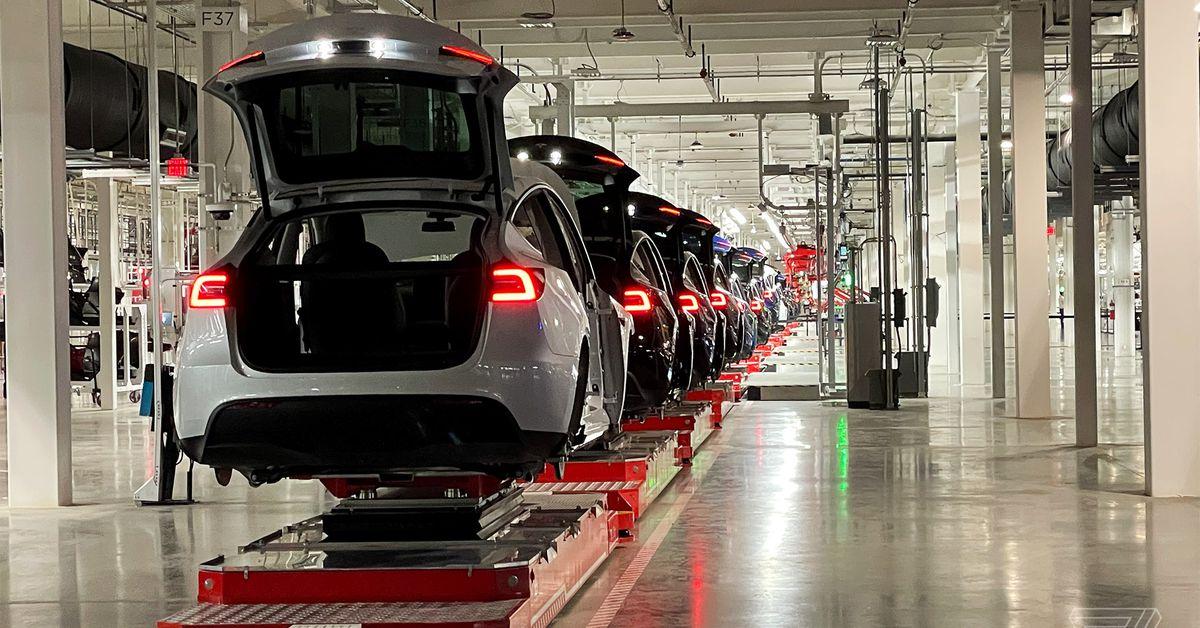Tesla is closing in on a new manufacturing process that could significantly reduce costs and increase production of its electric vehicles. According to sources who spoke to Reuters, the new process will enable the automaker to die-cast almost the entire vehicle underbody as a single piece instead of building out about 400 parts using conventional car-building techniques.
- Home
- Technology
- News
Tesla’s new car-building process could be a huge industrial breakthrough
Tesla is reportedly close to building a new gigacasting die-cast process to build its possibly Cybertruck-like $25,000 car using techniques new to the automaking industry.


Tesla’s current process to build its popular Model Y SUV already involves a unique use of massive, ultra-high pressure presses that can mold both the front and rear parts of the vehicle. Tesla calls this process “gigacasting,” which some experts say is already highly efficient and cost-effective compared to other automakers’ factories. But now Tesla is looking to up the ante.
Tesla’s secret new technique starts with an updated mold-making process using 3D printing and sand
Tesla’s secret new technique starts with an updated mold-making process that the sources tell Reuters uses 3D printing and industrial sand. When creating molten metal molds, it can cost millions to make simple tweaks when scaled up to the size of a vehicle, so automakers generally shy away from the option.
But Tesla is moving forward with it using a new technique with sand that can build the mold layer by layer and make it easier to alter afterward. According to Reuters, aluminum alloys used to produce castings weren’t behaving as expected, but casting specialists altered the alloy formula and fine-tuned the cooling and heat treatment processes to make it work.
Tesla could cast an entire underbody in one piece instead of two or more
Once achieved, Tesla could cast an entire underbody in one piece instead of two or more with the current process. Generally, vehicle underbodies are built by welding pieces together and leaving a hollow subframe that structurally helps the car in the event of a crash. But Tesla plans to do it in one gigacasting using a new mold that includes 3D-printed solid sand cores inside. After casting, the sand is removed, leaving the same hollow subframe without needing to weld pieces together.
The new casting technique is reportedly reaching the tail end of development but also includes some new hurdles. First, the sources said Tesla would need more powerful “gigapresses” and at substantially larger sizes compared to the already house-sized ones in use. That also means Tesla would need more space to accommodate these new presses. Secondly, at higher pressures, the 3D-printed sand core technique might not work. Another option could involve slow molten alloy injection to accommodate the sand cores, but this would slow down manufacturing.
If Tesla can figure out the last steps, it could be key to speeding up its assembly line process. Tesla CEO Elon Musk mentioned a new “unboxed” production process as part of his third Master Plan for the company. The process could speed up car building by starting with the single-piece cast, painting only the parts that need to be painted, and assembling the rest of the parts all in one go.
On a much larger scale, Tesla’s manufacturing breakthroughs are similar to how Apple switched to a unibody design for its laptops — where the full structure of the product comes from machining one aluminum slab and saves on assembly costs. Tesla reportedly plans to use the latest processes on its long-awaited $25,000 electric car, which might now look a bit like the Cybertruck. Meanwhile, Tesla is distracting itself with the overly complicated design and manufacturing process of the Cybertruck in contrast to this.
During Tesla’s Investor Day event in March, Musk described plans to halve the manufacturing costs of its EVs — if the engineering works out. The company has already slashed the prices of its vehicles, including the Model S and X, which could mean demand is slowing or perhaps that Tesla’s anticipating its new process is nearing.
Bollywood studio Bhansali Productions to sell future film music to Saregama India
- an hour ago
Former Punjab CM Manzoor Wattoo passes away at 86
- 2 hours ago

Gold prices dip per tola in Pakistan, global markets
- an hour ago

Why Republicans in Congress are turning against Trump
- 13 hours ago

Zillow’s short-sighted move to overlook climate risk
- 4 hours ago

The biggest mosquito-borne disease in the world has a cure. There’s just one problem
- 13 hours ago

Chatbots are struggling with suicide hotline numbers
- 15 hours ago

Control’s action-RPG sequel launches in 2026
- 15 hours ago
Sabalenka named WTA Player of the Year for second straight season
- an hour ago
FIFA hails 5M WC ticket requests amid backlash
- 14 hours ago
Bondi gunman’s Indian family had no knowledge of his radicalisation, Indian police say
- an hour ago

Disney wants to drag you into the slop
- 15 hours ago







